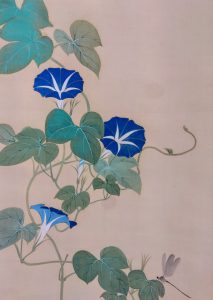この夏は何本食べることになるでしょうか(愛知県名古屋市千種区姫池通 骨董買取 古美術風光舎)
2024.07.06
みなさまこんにちは、スタッフTでございます。
暦の上では二十四節気が夏至から小暑(しょうしょ)へと変わりました。「小暑(しょうしょ)」とは、梅雨が明け、暑さが本格的になる時期のことを指します。
いよいよ蝉も鳴き始め、暑中見舞いを出すのもこの頃です。うっかりすると暑中見舞いを出してしまいそうな暑さでしたので、今ならもう胸を張って、暑中お見舞いを申し上げられますね。 これからの猛暑を乗り切るために、たくさん食べ、体力をつけておきたいところです。

さて、夏もおいしいものがたくさんあります。ナスにキュウリにトマトの三大夏野菜を始め、スイカにメロンにモモ、とみずみずしい果物もうれしい味です。もうひとつ、夏ならではの、明るく元気いっぱいで食べられるものといえば、トウモロコシ。
季語でいうと、トウモロコシの花は夏、実は秋に分類されるようですが、感覚としては夏の食べ物です。そういえば、近頃の夏祭りの屋台で焼きとうもろこしを見かけなくなった気がしますが、皆さまの地域はいかがでしょうか。あの香ばしい醤油の焦げた香りはお祭りの気分がとても上がるのですが…。
トウモロコシは、メキシコにて約5000年以上前から栽培されていたと言われています。15世紀末に新大陸を発見したコロンブスがヨーロッパに持ち帰って広まり、日本へは江戸時代にポルトガル人が日本へ持ち込み、北海道から順に普及していきました。
ポルトガルから伝わったトウモロコシですが、当時の日本は輸入品すべてを中国から入ってきたものとして、「唐」と呼んでいました。トウモロコシの形が「もろこし」という作物に似ていることから、唐もろこしと呼ばれるようになったようです。
トウモロコシは漢字で書くと「玉蜀黍」です。初見ではなかなか読めないですね。「もろこし」を漢字で書くと「蜀黍」であるため、とうもろこしが日本に伝わってきた当初は「唐蜀黍」だったそう。その後、とうもろこしの粒が綺麗で並びが美しいことから、「唐」の代わりに宝石を表す「玉」の字を充てて「玉蜀黍」と書くようになったんだとか。
南米など、地域によっては主食にしている人々もいますので、穀物であるトウモロコシは重要な作物です。日本では主食の地位は得られませんでしたが、夏の野菜売り場ではいい位置をキープしています。
トウモロコシのいいところは、茹でるだけでおやつとしてそのまま食べられるところではないでしょうか。ハッピーイエローの粒々は食欲をそそりますし、見た目の愛嬌もたっぷり。
いざ調理をというときは、広げた新聞紙の上で、農家の方への感謝しつつ、実を包んで守っている何枚もの皮を、そろりそろりと剥いでいきます。皮がとれてくると、真新しいツヤツヤの可愛らしい実が現れます。粒々たちは、お行儀よくみっちり並んで笑っているように見えてきます。
茹で上がったトウモロコシを「ハーモニカ食い」するのは夏しか味わえない至福の時間。
この夏は、何本のトウモロコシを食べることになるでしょうか。粒々なので、細かく刻む手間もありません。オリジナルのお料理など考案して、ハッピーイエローを楽しみたいと思います。
ではでは、また。
Hello everyone, this is Staff T.
According to the calendar, the 24th day of the month has changed from summer solstice to “Shosho” (short summer heat). Shosho” refers to the time when the rainy season is over and the heat is in full swing.
The cicadas finally begin to sing, and this is also the time when we send out our summer greeting cards. It has been so hot that we might have inadvertently sent out a hottest summer greeting card, so now we can now offer a hottest summer greeting card with our hearts in our mouths. In order to survive the coming heat wave, we should eat a lot and keep our strength up.
Well, there are many delicious foods in summer as well. Eggplant, cucumber, and tomato are the three major summer vegetables, and fresh fruits such as watermelon, melon, and peach are also a delight. Another thing that can be eaten with bright and full of energy, which is unique to summer, is corn.
In terms of seasonal words, corn flowers are classified as summer and corn is classified as autumn, but in the sense of the word, corn is a summer food. Come to think of it, I don’t think I have seen grilled corn at summer festival stalls in recent years, but how about in your area? The aroma of the burning soy sauce is a very uplifting smell at festivals, but….
Corn is said to have been cultivated in Mexico for more than 5,000 years, and was brought back to Europe by Columbus, who discovered the New World at the end of the 15th century, and spread to Japan by the Portuguese in the Edo period (1603-1868), starting from Hokkaido.
Although corn was introduced from Portugal, Japan at that time called all imported products “Tang” as if they came from China. It seems that the name “Tang corn” came about because the shape of corn resembles a crop called “maize.
Corn is written in Chinese characters as “gyokushokubi. It is not easy to read at first sight. The Chinese character for “corn” is “shokubi,” so when corn was first introduced to Japan, it was called “karashokubi. Later, because the grains of corn are beautifully arranged, the character for “jewel” was substituted for “tang” and the name was changed to “gyokushokubi”.
Corn, a grain, is an important crop because in some regions, such as South America, people use it as a staple food. In Japan, it has not achieved the status of a staple food, but it keeps a good position in the vegetable market in summer.
The good thing about corn is that it can be simply boiled and eaten as is as a snack. The happy yellow grains are appetizing and have a charming appearance.
When it comes time to cook the kernels, we peel off the many layers of skin that surround and protect the kernels on a sheet of newspaper, thanking the farmers for their kindness. When the skins are removed, brand-new, shiny, and lovely berries are revealed. The kernels are lined up in a neat row, looking as if they are smiling.
Eating boiled corn “harmonica-eating” is a blissful experience that can only be enjoyed in summer.
How many stalks of corn will we eat this summer? Since the corn is in grains, there is no need to chop it into small pieces. I would like to enjoy the happy yellow color by inventing original dishes.
See you soon.
*******************
ご実家の整理やお片付けなどをされている方のご相談などが多くございます。
お片付けなどくれぐれもご無理のないようになさってくださいませ。
風光舎では古美術品や骨董品の他にも絵画や宝石、趣味のお品など様々なジャンルのものを買受しております。
お片付けをされていて、こういうものでもいいのかしらと迷われているものでも、どうぞお気軽にご相談下さいませ。
また風光舎は、出張買取も強化しております。ご近所はもちろん、愛知県内、岐阜県、三重県その他の県へも出張いたします。
まずは、お電話お待ちしております。
愛知県名古屋市千種区姫池通
骨董 買取【古美術 風光舎 名古屋店】
TEL052(734)8444
10:00-18:00 OPEN

